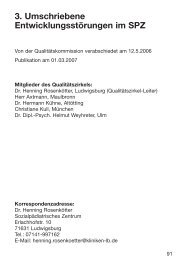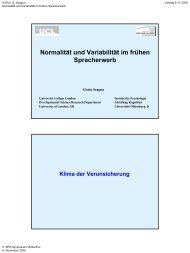(Central) Auditory Processing Disorders - Technical Report
(Central) Auditory Processing Disorders - Technical Report
(Central) Auditory Processing Disorders - Technical Report
- No tags were found...
You also want an ePaper? Increase the reach of your titles
YUMPU automatically turns print PDFs into web optimized ePapers that Google loves.
8 / 2005<br />
American Speech-Language-Hearing Association<br />
tory processing disorder. In any case, central auditory<br />
test results obtained from persons with hearing loss<br />
should be interpreted with caution. The validity of<br />
these and other strategies used to separate peripheral<br />
from central effects must be ascertained through further<br />
research and should only be applied when absolutely<br />
necessary.<br />
It is critical that a complete assessment of the<br />
peripheral auditory system, including consideration<br />
of auditory neuropathy/auditory dys-synchrony<br />
(AN/AD), occur prior to administering a central auditory<br />
test battery. At minimum, this would include<br />
evaluation of hearing thresholds, immittance measures<br />
(tympanometry and acoustic reflexes), and<br />
otoacoustic emissions (OAEs). When contradictory<br />
findings exist (e.g., present OAEs combined with<br />
absent acoustic reflexes or abnormal hearing sensitivity;<br />
abnormal acoustic reflexes with normal tympanometry<br />
and OAEs), additional follow up should occur<br />
to rule out AN/AD prior to proceeding with central<br />
auditory testing.<br />
Clinical Decision Analysis Regarding<br />
Test Selection<br />
The application of clinical decision analysis allows<br />
clinicians to evaluate the performance of diagnostic<br />
tests, such as those used for (C)APD, as well<br />
as to understand the probabilistic uncertainties associated<br />
with these tests (see Turner, Robinette, &<br />
Bauch, 1999, for review). Clinical decision analysis<br />
assumes that only two states exist: (1) that the individual<br />
has the disorder or dysfunction, or (2) that the<br />
individual does not have the disorder or dysfunction.<br />
Thus, any test for consideration only has two outcomes:<br />
(1) When positive, the test identifies the dysfunctional<br />
state, and (2) when negative, the test rules<br />
out the dysfunctional state. Clinical decision analysis<br />
provides information regarding test sensitivity,<br />
test specificity, and test efficiency, which are pivotal<br />
to a test’s clinical utility.<br />
Sensitivity refers to the ability of the test to yield<br />
positive findings when the person tested truly has the<br />
dysfunction. The sensitivity of a test is the ratio of the<br />
number of individuals with (C)APD detected by the<br />
test compared to the total number of subjects with<br />
(C)APD within the sample studied (i.e., true positives<br />
or hit rate). Specificity refers to the ability to identify<br />
correctly those individuals who do not have the dysfunction.<br />
The specificity of the test is the ratio of normal<br />
individuals (who do not have the disorder) who<br />
give negative responses compared to the total number<br />
of normal individuals in the sample studied,<br />
whether they give negative or positive responses to<br />
the test (i.e., 1 – sensitivity rate). Although the specificity<br />
of a test typically decreases as the sensitivity of<br />
a test increases, tests can be constructed that offer<br />
high sensitivity adequate for clinical use without sacrificing<br />
a needed degree of specificity.<br />
The estimates of sensitivity and specificity of a<br />
symptom, test, or measure allow us to compute the<br />
predictive values of protocols used to make an appropriate<br />
decision or diagnosis. Efficiency is the combination<br />
of sensitivity and specificity. The computation<br />
of test efficiency is dependent on defining a gold standard,<br />
derived from well-defined, documented populations<br />
of individuals with the disorder and<br />
populations of individuals documented to be free of<br />
the disorder. Because of the variability and the nature<br />
of the profiles of (C)APD, there exists no absolute<br />
gold standard for deriving sensitivity and specificity<br />
data for tests of central auditory dysfunction; however,<br />
several options for determining test efficiency<br />
have been suggested. One option involves the use of<br />
children and adults referred for central auditory testing<br />
due to difficulties listening in noise and other<br />
behavioral symptoms of (C)APD. However, because<br />
the behavioral symptoms of (C)APD are also common<br />
to many other disorders (e.g., LD, ADHD, language<br />
disorder), it is not possible to state a priori whether a<br />
given individual in this population exhibits central<br />
auditory dysfunction or some other, similar disorder.<br />
As such, if efficiency data for tests of central auditory<br />
dysfunction were to be established on a population<br />
suspected of having central auditory dysfunction,<br />
there would be no means of establishing true measures<br />
of sensitivity and specificity.<br />
Similarly, the use of children with LD to determine<br />
the predictive value of tests of central auditory<br />
processing is problematic. Although many children<br />
referred for diagnostic central auditory assessment<br />
exhibit some type of learning difficulty, the population<br />
of children with LDs is heterogeneous, and the<br />
relationship between (C)APD and LD is complex.<br />
Many children with LD do not exhibit auditory processing<br />
disorder, and auditory processing disorder<br />
does not necessarily lead to LDs. Therefore, it is impossible<br />
to state a priori whether a given child with<br />
LD exhibits (C)APD. Further, a significant proportion<br />
of the population with (C)APD consists of adults with<br />
auditory complaints who may or may not have exhibited<br />
learning difficulties as a child. Consequently,<br />
if populations with LD were used for sensitivity/<br />
specificity purposes, the results would provide a<br />
measure of test efficiency for LD rather than for<br />
(C)APD as, again, there would be no means of determining<br />
if the children in the chosen LD population<br />
actually exhibit central auditory dysfunction nor how<br />
this information applies to adults.







